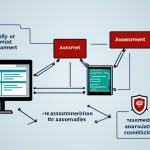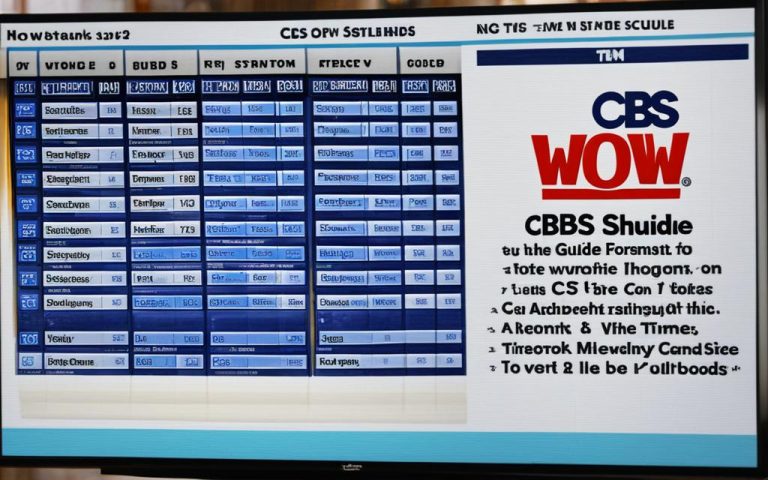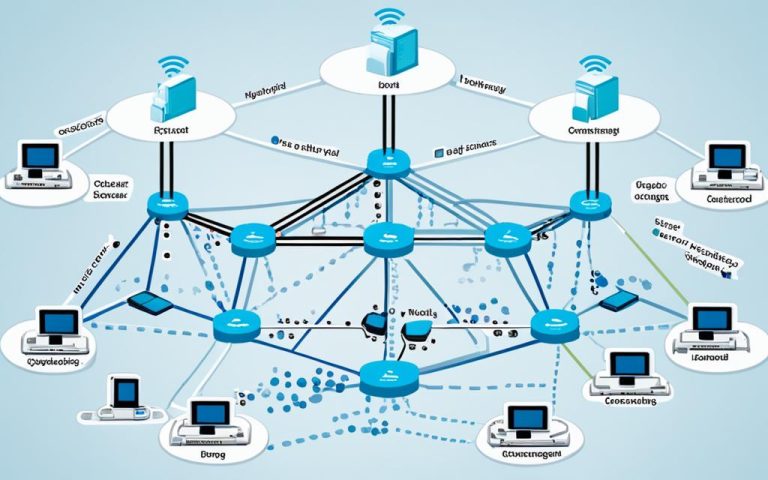Network partitioning, also known as network segmentation, is key to keeping user connections safe. It makes a wall between the user’s device and the network. This makes online interactions more secure and protects against threats1.
This method keeps different devices in separate groups. It helps reduce risks and makes it easier to handle cyber threats. By doing this, we can fight off attacks more effectively1.
Key Takeaways:
- Network partitioning makes online interactions safer for users.
- It keeps devices in separate groups to lower risks and reduce cyber threat impact.
- Managing how devices talk to each other is key in case of security issues.
- It involves making a barrier between the user’s computer and the network.
- Using network partitioning boosts an organization’s security level.
Why is Network Partitioning Important?
Network partitioning is key to keeping computer connections safe and efficient today. With cyber threats on the rise, it’s vital for businesses and individuals to manage their networks well. This helps protect sensitive data and reduce risks.
One big reason for network partitioning is to manage bandwidth well. How you share bandwidth affects your network’s performance. By setting aside specific bandwidth for important tasks like point-of-sale systems and VoIP, businesses can keep things running smoothly and give users a great experience2.
Partitioning a network also means setting aside bandwidth for certain tasks. This lets businesses focus on what’s most important and add an extra layer of security. It’s a smart way to manage resources and lower risks2.
It’s important to figure out how much bandwidth you need for partitioning. This ensures that critical tasks get enough bandwidth without slowing down the network. It helps businesses balance how they use resources and manage risks2.
Looking at network needs is key to deciding how to allocate bandwidth. This helps make sure the network works well and supports important tasks. It’s all about finding the right balance between using resources wisely and keeping risks low2.
Network partitioning also ties into the CAP theorem, which talks about distributed systems. The theorem says a system can have at most two of three things: consistency, availability, and tolerance for network partitions3. NoSQL databases fit into this theorem based on what they offer. Some databases focus on consistency and can handle network partitions, while others aim for availability and can lose consistency3.
Fixing network partitions often means keeping data consistent, even if it means services are unavailable4. Databases like Cassandra and MongoDB use the CAP theorem in different ways. Cassandra goes for availability and can handle network partitions, but might not always keep data consistent. MongoDB, on the other hand, puts consistency first, even if it means services are down43.
In summary, network partitioning is crucial for today’s cybersecurity needs. By managing resources well and applying the CAP theorem, businesses can boost their network security. This leads to better performance and keeps critical services running without interruption.
Prerequisites for Network Partitioning
To set up network partitioning, users must check if their network router can handle it. It should support gateway capability, creating multiple networks, and have firewall support5.
Network routers are key in network partitioning. They manage traffic between different parts of the network. A router with gateway capability lets you create separate network areas. This makes organizing and controlling traffic easier.
Being able to make several networks is crucial. It lets users split their network into different parts. Each part can have its own IP range and security settings.
Firewall support is also essential. It keeps each network part safe and secure. Firewalls block unauthorized traffic and let only approved traffic through.
Sometimes, users need extra hardware like a managed switch or a firewall device5. These tools offer better management and security for network partitions.
Benefits of Network Partitioning
Network partitioning has many benefits for companies. It boosts network performance by improving traffic flow and reducing congestion. By grouping data based on how it’s used, queries run faster and more efficiently5.
It also makes storage more efficient, especially for data that takes up a lot of space or has special storage needs5. This cuts down on storage costs and speeds up data access.
Managing data becomes easier with network partitioning. It allows for changes to certain data parts without affecting the whole dataset5. This helps companies adapt quickly to new data needs.
Another big plus is how it helps keep data safe and private. By putting sensitive data in its own area, companies can control who sees it5.
Many sectors like e-commerce and healthcare use network partitioning to handle their data well. In e-commerce, it’s used for user info and product lists. Healthcare uses it for patient records and medical info5.
| Benefits of Network Partitioning | Statistical Data References |
|---|---|
| Optimizes network performance by processing queries involving a subset of columns more efficiently | 5 |
| Optimizes storage efficiency for columns with large amounts of data or different storage requirements | 5 |
| Simplifies data management by allowing independent modification or management of specific subsets of columns | 5 |
| Enhances data security and privacy by separating sensitive or confidential columns into their own partitions | 5 |
| Widely used in industries such as e-commerce and healthcare | 5 |
Identifying Device and User Groups
The first step in network partitioning is to sort devices and users into groups. This makes it simpler to set up network segments and control who can talk to whom.
There are several types of device groups. Laptops, phones, and tablets are one group. Work PCs and laptops are another. IoT devices like smart lights and speakers are a third. Home labs with servers are a fourth group. This way, it’s easier to manage network resources and permissions.
It’s also key to sort users into groups. These groups include regular users, guest users, and admin users. Regular users are people who need basic access. Guest users are temporary or outside people with limited access. Admin users have the power to manage the network.
Knowing the different groups in a network helps admins plan better. They can set up network segments to keep devices and users safe. For instance, putting IoT devices in their own network segment helps protect them from harming the rest of the network (“6“).
Identifying Risks
When setting up network partitioning, it’s key to spot and fix risks that could harm the network’s security and device safety.
One big risk is network breaches, which let unauthorized people get to sensitive data and network stuff. These breaches happen because of weak spots in the network or not enough security steps. It’s vital to tackle these risks to keep out viruses and stop unauthorized access to devices.
Another big risk is viruses spreading through the network, which can mess up the whole system. Infected devices can let malware in and are a big threat to network security. With network partitioning, infected devices can be kept away from the rest of the network, stopping viruses from spreading.
Also, devices that get hacked are a big worry for network security. If a device gets hacked, it can let attackers into sensitive data or control important network stuff. Network partitioning helps by keeping these hacked devices in their own network parts. This limits how much damage they can do and cuts down on unauthorized access to key systems.
By spotting and fixing these risks with network partitioning, companies can make their security better and protect against threats.
| Risks | Impact | Source |
|---|---|---|
| Network Breaches | Unauthorized access to sensitive data | 7 |
| Virus infections | Spread of malware throughout the network | 7 |
| Compromised devices | Unauthorized access to critical resources | 7 |
Partitioning Your Network
Network partitioning is key to keeping user connections safe and private. It divides a network into subnets for better control and security. This method helps protect sensitive data by creating separate areas within a network.
Understanding Subnets and IP Ranges
Subnets help achieve network partitioning. They let you separate devices into groups with their own IP ranges. This makes managing and securing your network easier.
When setting up subnets, think about how big each should be and how many IP addresses you need. This ensures devices in a subnet talk to each other well and keeps out unwanted visitors. The IP range sets how many devices can connect in each subnet.
Best Practices for Network Partitioning
To get network partitioning right, follow best practices for your network’s needs. Here are some important tips:
- Understand your network’s needs and how different tasks use resources. This helps you decide where to partition your network.
- Reserve bandwidth for important tasks, like you would book a table at a restaurant. This keeps critical processes running smoothly.
- Decide which tasks or groups need their own partition. Use authentication to control access and make sure resources are used well.
- Keep checking and improving your network to make sure it works well. Watch how it performs, look at traffic, and adjust as needed.
- Keep your list of needed ports up to date. This helps avoid wasting resources and keeps communication between partitions smooth.
- Consider getting help from managed IT services, like GeekBox IT. They can make network partitioning easier and improve your network’s performance.
By using network partitioning and these tips, you can make a secure and efficient network for your group or home. With networks getting more complex, it’s key to keep up with security to protect your data and stay safe from threats.
For more on network partitioning and keeping your computers safe, check out these resources:
- Here is a helpful thread where people share their experiences and advice on partitioning and network drives.
- Discover how to partition your home network and the role of Ubiquiti UniFi in advanced setups here.
- GeekBox IT’s blog has great advice and insights on network partitioning and managing resources.
In summary, using subnets and IP ranges for network partitioning is a smart way to keep your connections safe and data secure. With the right practices and help from experts like GeekBox IT, your network can stay strong and ready for new security challenges.
Setting Up Firewalls
After setting up network partitions, it’s key to set up firewalls. Firewalls help manage traffic flow and enforce rules and protocols. By setting rules and configuring firewalls, users can control who can talk to whom in the network8.
Today’s firewalls are advanced and customizable. Users can set up rules to filter traffic. This ensures only approved communication gets through8.
When setting up a firewall, figuring out the network’s security level is important. Home users might just need a basic setup. But businesses or groups with sensitive data need a stronger firewall8.
Creating rules for ports, protocols, and IP addresses helps control traffic. This stops unauthorized access to important data, making the network safer8.
Adding security tools like antivirus software and keeping software updated also helps protect the system. Staying on top of security keeps users safe and secure online8.
Rule Prioritization for Effective Traffic Control
Rule prioritization is key for a firewall’s traffic control. It lets admins set a order for traffic checks and blocks or allows it. This makes sure important services get through while blocking unwanted traffic8.
Admins can give certain rules priority based on the service type, security needs, and network impact. This gives detailed control over traffic. It makes sure key services and apps get the needed resources and safety8.
Testing and Optimization
After setting up network partitions and firewalls, it’s key to test and improve the network. Make sure everyone can access the internet, test features like AirPrint and AirPlay, and use shared devices like NAS. Testing and optimizing helps find and fix problems, making the network work better9.
Testing how well the network performs is vital. By testing real-life scenarios, we can see how fast, reliable, and big the network can be. This helps find and fix any slow spots or areas that need work, making the network run smoother9.
Load testing shows how the network handles lots of users and data at once. It checks if the network can grow with more users without slowing down. This ensures the network can handle more users without problems9.
Testing for security is also key. By testing for weak spots, we can fix them before hackers find them. This keeps the network safe from cyber threats and protects data, making it work better9.
Optimizing the network means always checking and adjusting it. Tools help track things like internet speed, delays, and lost data. This info helps improve how the network is set up and used. Quick fixes keep the network running smoothly9.
Admin Network and Micro-Partitioning
Network partitioning splits a computer network into smaller, safe parts. It helps protect the network and reduce risks. Creating an admin network gives special access to network managers10. This network lets them make changes safely.
But, be careful with micro-partitioning to keep the network running well. It makes the network safer by breaking it into smaller, secure areas11. But too much division can slow things down. It’s important to think about what your network really needs.
Technologies like Segmentation with SDN and Micro-Segmentation give more control and are easier to manage10. They help set up detailed security rules for each application. This keeps data safe and limits the spread of cyber threats10.
Admin Partitions, like those from Citrix ADC, let many users share one network safely12. They help manage resources and IP addresses without problems. It’s great for big companies. Remember, give at least 50% of memory to the main partition for flexibility12.
Isolating networks is key in admin partitions. It means setting up different VLANs and routes for each part12. This keeps each part safe from others. Showing only the right info for each partition also helps keep things secure12.
For big companies, each app might need its own setup in admin partitions12. This means different features and settings for each one.
Overall, using admin networks and micro-partitioning makes networks safer and easier to manage. It helps use resources well and keeps important data safe101211. By doing it right, companies can keep their data and ideas safe from cyber threats101211).
Conclusion
Network partitioning is key for better network security, risk reduction, and keeping networks running smoothly. By sorting devices and users into groups and knowing the risks, we can protect our networks and data from hackers. Using subnets, firewalls, and other tools also boosts security and stops attacks.
It’s also vital to test and improve the network regularly. Keeping an eye on the network and making adjustments helps it work better and adapt to new needs. This makes the network faster and less likely to break down.
Network partitioning is crucial for keeping networks safe and running well. By using the right methods and staying updated with new tech, we can keep our networks secure and efficient. This helps protect our data and keeps our networks strong against threats131415.
FAQ
What is network partitioning?
Network partitioning means separating a user’s computer from the network it connects to. This makes online interactions safer and more secure.
Why is network partitioning important?
It’s key because it shields users from hackers and those wanting their info. By managing device groups, it lowers cyber threat risks and minimizes their effects.
What are the prerequisites for network partitioning?
You need a network router that supports gateways, multiple networks, and firewalls. Sometimes, you’ll also need a managed switch or firewall for better control.
How do I identify device and user groups for network partitioning?
First, sort devices into groups like user, work, IoT, and home lab devices. Define user groups like regular, guest, and admin users. This helps segment the network and manage access and communication.
What should I consider when identifying risks for network partitioning?
Think about threats like devices spreading viruses, IoT hacking, or work devices getting hit by ransomware. Knowing these risks helps set up safe network boundaries.
How can I partition my network?
Use subnets to partition your network. Assign each subnet an IP range to separate devices and user groups. This makes managing and securing your network easier.
How do I set up firewalls for network partitioning?
Firewalls control traffic between network parts. Set rules and protocols to allow or block communication. This keeps your network secure and organized.
What is the importance of testing and optimization in network partitioning?
Testing and optimizing ensure your network partitions work well. Check internet access, test features like AirPrint, and access shared devices. This helps fix issues and improve network performance.
What is an admin network and how does micro-partitioning work?
An admin network gives network admins access to make changes safely. But, be careful with micro-partitioning as too many can slow down your network. Finding the right balance is key.
How does network partitioning enhance network security?
It boosts security by securing user connections and reducing online risks. By grouping devices and understanding threats, using subnets and firewalls, and testing, you can greatly improve your network’s safety.
Source Links
- https://www.sciencedirect.com/topics/computer-science/network-partition – Network Partition – an overview
- https://nutechology.com/blog/partition-your-network-to-prioritize-network-resources/ – Partition Your Network to Prioritize Network Resources – NuTech Services, LLC.
- https://www.ibm.com/topics/cap-theorem – What Is the CAP Theorem? | IBM
- https://www.scylladb.com/glossary/cap-theorem/ – CAP Theorem
- https://medium.com/@roopa.kushtagi/partitioning-in-distributed-systems-ade2fd0cc3ed – Partitioning in Distributed Systems
- https://learn.microsoft.com/en-us/windows-server/networking/core-network-guide/core-network-guide – Core network components
- https://www.varonis.com/blog/network-segmentation – What Is Network Segmentation?
- https://medium.com/@tj7771829/breaking-down-the-barrier-navigating-the-partition-between-your-computer-and-the-network-60161a5d67ff – “Breaking Down the Barrier: Navigating the Partition Between Your Computer and the Network”
- https://learn.microsoft.com/en-us/azure/well-architected/performance-efficiency/scale-partition – Recommendations for optimizing scaling and partitioning – Microsoft Azure Well-Architected Framework
- https://www.zenarmor.com/docs/network-basics/network-segmentation – What Is Network Segmentation? Introduction to Network Segmentation – zenarmor.com
- https://www.geeksforgeeks.org/what-is-network-segmentation/ – What is Network Segmentation? – GeeksforGeeks
- https://community.citrix.com/articles/security/design-admin-partitions-part-1/ – NetScaler ADC Admin Partitions Validated Reference Design
- https://medium.com/baseds/parsing-through-partitions-in-a-distributed-system-3c1723fecc4e – Parsing Through Partitions in a Distributed System
- https://medium.com/@kmrpushkar09/cap-theorem-explained-consistency-availability-partition-tolerance-19d151db54f3 – CAP Theorem Explained — Consistency, Availability & Partition Tolerance.
- https://www.cs.purdue.edu/homes/fahmy/papers/partition.pdf – http11_sess.eps



















